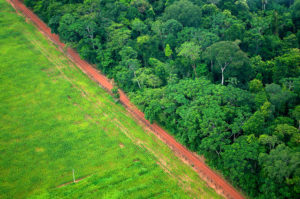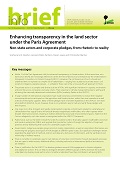
By Niki de Sy, originally posted at CIFOR’s Forests News
Many countries have included agriculture, forestry and other land use targets in their Nationally Determined Contributions (NDCs) to fight climate change as part of the Paris Agreement.
The land use sector is particularly important because it holds many links to food security, economy, well being, and the Sustainable Development Goals (SDGs). This sector is also unique because of its huge carbon sink potential. In developing countries, land use change (i.e. deforestation) and agriculture are often the largest source of greenhouse gas (GHG) emissions.
Unfortunately, emissions from land use change are notoriously hard to quantify and monitoring capacities in many developing countries remain low.
The Enhanced Transparency Framework was established to enable the tracking, comparing and understanding of national commitments worldwide to fight climate change. Countries will need to provide necessary information to track progress towards implementing and achieving their NDCs and on reducing GHG emissions.
This information will be used for a Global Stocktake conducted every five years. The Paris Agreement also encourages other stakeholders, including civil society and the private sector, to participate in efforts to address and respond to climate change.

This means that land use sector information will be needed for quantifying and tracking progress made at the local, national and global levels, as well as for guiding local mitigation planning and implementation of land use activities, and the accountability of actions and stakeholders (i.e. for tracking corporate ‘zero deforestation’ commitments).
A variety of stakeholders (governments, private sector, land managers, etc.) will increasingly look for trusted and reliable information, ready to-use methods and open-source solutions that would allow them to assess the state, dynamics and drivers of change regarding land resources, livelihoods, social protections and equity indicators.
There is a need for enhanced monitoring approaches that stakeholders can use to achieve their own goals, but that would also be perceived as transparent and legitimate by other stakeholders. They should also support accountability of all stakeholders within the framework of the Paris Agreement.
INNOVATION REQUIRED
It is clear that beyond the efforts of national governments to monitor their emissions from the Agriculture, Forestry and Other Land Use (AFOLU) sector, there is a need for additional monitoring approaches. A recent infobrief published by the Center for International Forestry Research (CIFOR) provides insight into the role of independent monitoring approaches in enhancing transparency in the land use sector.
Results from a multi-stakeholder survey show that independent monitoring does not mean one specific tool, but rather a diversity of approaches with the purpose of increasing transparency and broadening stakeholder participation by providing free and open methods, data, and tools complementary to mandated reporting by national governments.
The CIFOR study gives key recommendations on how stakeholders can engage and benefit from independent monitoring. The authors recommend developing a practice of ‘data bridging’, not imposing a one-size-fits-all system, but rather simplifying and streamlining the dialogue between data users and producers.
The scientific community could play an important role by developing harmonized reference data, and guidance and training materials to make the best use of available data and information sources as it increases opportunities for participation and transparency.
Countries seeking to implement forest and agriculture-related mitigation actions could increase the use of open and ready-to-use tools to encourage participatory monitoring.
UNFCCC negotiators and reviewers could contribute by providing modalities and good practice guidelines for enhancing transparency and accountability in the land-use sector.
While the report provides a good starting point for discussions on enhanced transparency in the land use sector and the implications for monitoring, there are many other thorny issues that need to be considered going forth.
One major challenge will be to integrate biophysical information, obtained by field inventories and remote sensing, with survey and census data on livelihoods, social protection and equity indicators to better understand land use dynamics.
We should not only monitor climate goals, but also institutional change and social processes, which makes this even more complicated. Multiple sources and types of monitoring and reporting (i.e. national forest monitoring system, independent monitoring, private sector commitment tracking) will have to co-exist and be integrated into a multi-level, flexible and diverse system.
This is clearly an enormous task that demands a transdisciplinary approach. Enhancing transparency will require a giant effort, but it will hopefully lead to much-needed transformational changes to realize the full potential of the Paris Agreement, and beyond.
For more information on this topic, please contact Niki de Sy at niki.desy@wur.nl or Christopher Martius at c.martius@cgiar.org.
This research forms part of the CGIAR Research Program on Forests, Trees and Agroforestry.











